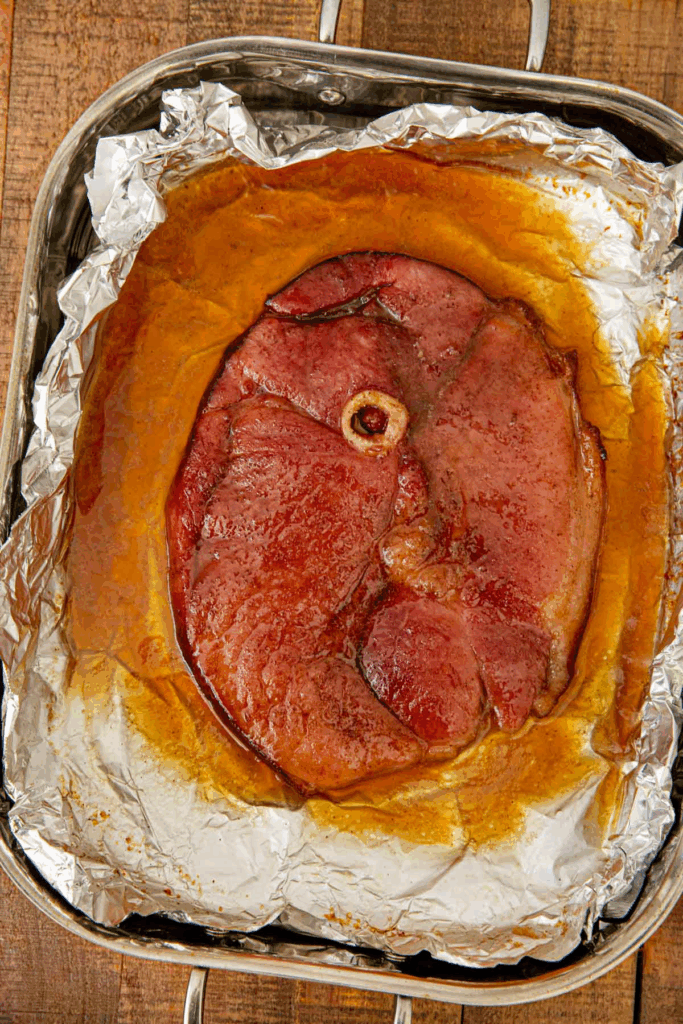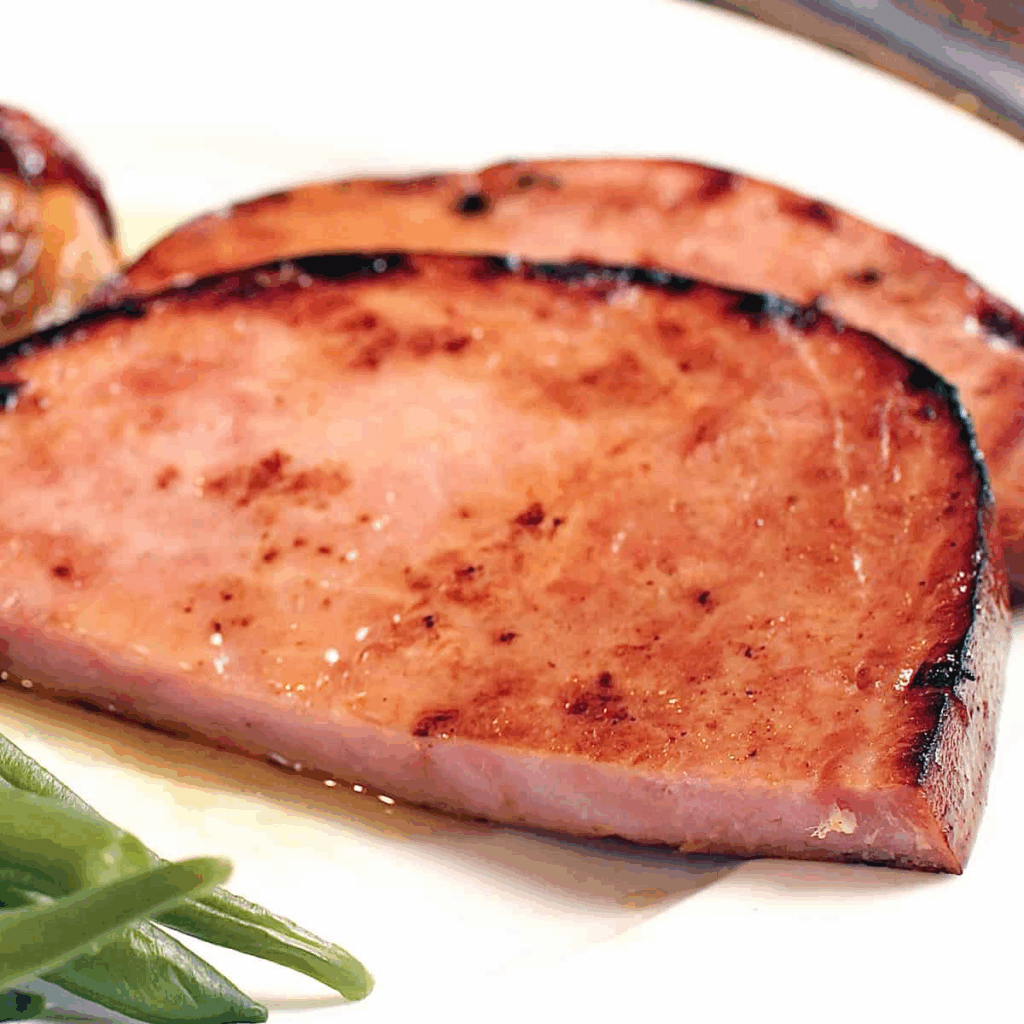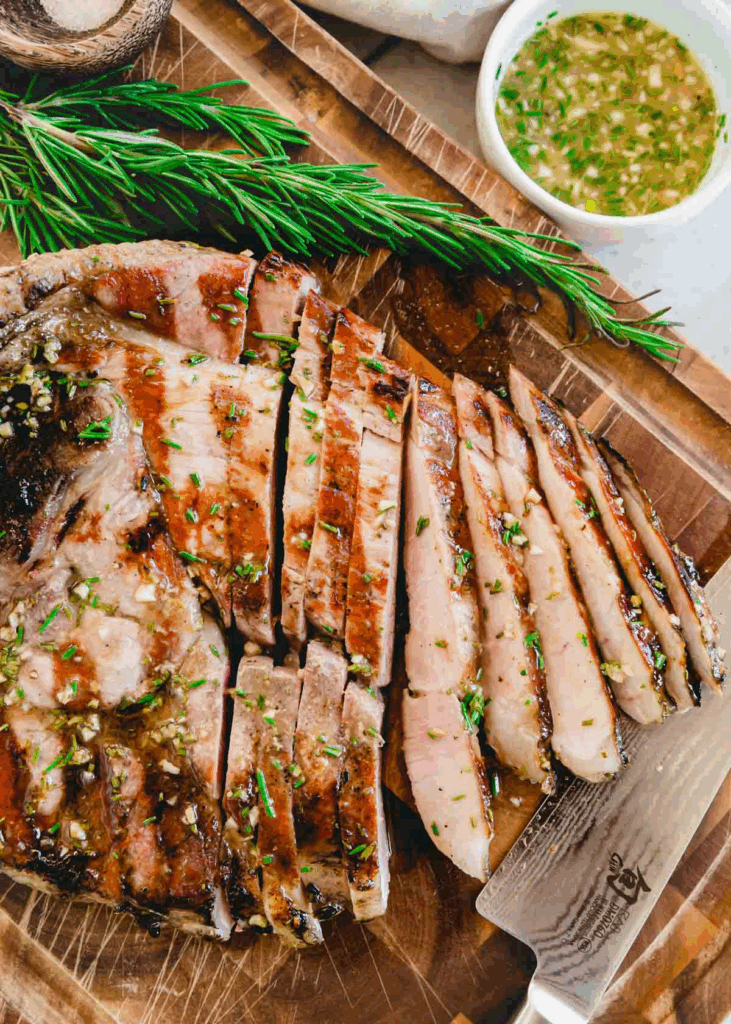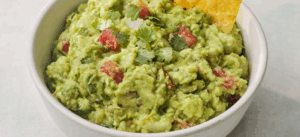How to Cook a Ham Steak
How to Cook a Ham Steak: Complete Guide to Flavor, Timing, and Versatility

In this guide, I’ll walk you through how to prepare and cook ham steak using several techniques I’ve used professionally and at home. Whether you want it pan-seared, baked, microwaved, or pressure-cooked, I’ll help you get the most out of every slice with flavor, timing, and temperature control in mind.
- Why Ham Steak Deserves a Spot in Your Kitchen
- What Is a Ham Steak and How It’s Made
- How to Choose a Quality Ham Steak
- How to Prepare a Ham Steak Before Cooking
- Essential Ingredients for Cooking Ham Steak
- How to Cook Ham Steak in a Skillet
- Oven-Baked Ham Steak: Moisture and Flavor Techniques
- Temperature and Doneness Table for Ham Steak
- Microwave Cooking for Ham Steak (When You’re in a Hurry)
- Common Mistakes When Cooking Ham Steak
- Best Sauces and Glazes to Serve with Ham Steak
- Recommended Seasonings and Flavor Pairings
- Recipe Variations Using Ham Steak
- How to Store and Reheat Ham Steak Properly
- How to Serve Ham Steak: Plating Tips and Pairing Ideas
- FAQ: 15 Questions About Cooking Ham Steak — Answered by a Chef

Why Ham Steak Deserves a Spot in Your Kitchen
Ham steak often gets overlooked in favor of whole hams or sliced deli meat, but for me, it’s one of the most efficient and flavorful cuts you can cook at home. Whether you need a quick breakfast protein, a hearty dinner centerpiece, or something that works equally well in a skillet or the oven, ham steak delivers on all fronts. It’s affordable, versatile, and packed with bold, smoky character that’s ready to go with minimal prep.
One of the great things about ham steak is that it comes in both fully cooked and raw forms, which gives you options depending on how much time you have. Pre-cooked ham steaks only need warming and browning, while raw ham steaks can be treated like pork chops—with brining, seasoning, and slow cooking for tender, juicy results.
What Is a Ham Steak and How It’s Made
A ham steak is a thick, cross-sectional cut from the whole ham—usually from the hind leg of a pig. It includes lean meat, marbling, and often a bit of fat cap or bone depending on the butcher’s trim. It’s typically sliced between ½ and 1 inch thick and can come either bone-in or boneless.
When you see bone-in ham steak, it usually includes the round leg bone in the center, which adds extra flavor during cooking. I prefer bone-in when roasting or glazing, but boneless is more convenient for pan cooking or cutting into cubes for recipes.
Ham steaks are either pre-cooked (fully cured and smoked) or uncooked (fresh or partially cured). You’ll know it’s pre-cooked if it’s labeled “ready to eat” or “fully cooked.” This version only needs reheating and caramelizing, which is great for weeknight meals. If the label doesn’t mention this, assume it’s raw and treat it like any fresh pork cut, cooking it to 145°F internal temperature.
Understanding the difference helps you determine how long and how hot you need to cook it. I always read the label carefully—there’s nothing worse than undercooking fresh ham steak because you mistook it for pre-cooked.

How to Choose a Quality Ham Steak
Choosing a good ham steak isn’t complicated, but it makes all the difference in flavor and texture. I always look for ham steaks with even color—a light to medium pink is ideal for fully cooked cuts. If the color is pale gray or overly wet, I skip it. For raw ham steak, the meat should be firm with a deeper red tone and some natural marbling.
Thickness matters. I prefer ham steaks around ¾ inch thick—they’re less likely to dry out and give me enough substance for a proper sear or oven glaze. Anything thinner than ½ inch cooks too quickly and risks turning rubbery, especially in the skillet.
If I’m planning to use a glaze, I check for a bit of surface fat—it renders beautifully and adds richness. A bone-in cut is my top choice for roasting or serving as a centerpiece, but for recipes where I’ll dice or slice the meat, I go boneless.
Lastly, I always check whether it’s water-added or natural. Water-added versions are usually pre-injected and cheaper, but they cook differently and can release a lot of liquid. I prefer natural or minimally processed steaks because they brown better and don’t lose as much texture during reheating.
How to Prepare a Ham Steak Before Cooking
Even though ham steak is one of the most convenient proteins to cook, a bit of prep makes a big difference—especially if you’re going for a restaurant-quality result. I always begin by patting the steak dry with paper towels. Excess surface moisture prevents browning and creates steam in the skillet or oven.
If the ham steak is pre-cooked, I usually score the surface lightly in a crosshatch pattern. This helps glaze cling better and allows fat to render evenly. If it’s a raw cut, I season it more aggressively—usually with a mix of salt, pepper, garlic powder, and smoked paprika. I let it rest for 20–30 minutes at room temperature to take the chill off and allow the seasoning to penetrate.
In some cases, especially for raw ham steaks, I marinate the meat in a blend of mustard, brown sugar, and apple cider vinegar. This adds flavor, but more importantly, it helps tenderize and balance saltiness. For pre-cooked ham, I skip marinating and instead focus on glazes added during cooking.
Before cooking, I always trim any tough skin or silverskin if present, but I keep the fat cap intact. That layer bastes the meat naturally and becomes beautifully crisp when pan-seared or broiled.

Essential Ingredients for Cooking Ham Steak
Here’s what I typically use when preparing ham steak, whether for skillet, oven, or pressure cooking. The list remains flexible depending on whether the cut is raw or pre-cooked:
- 1 ham steak (¾ to 1 inch thick, bone-in or boneless)
- 1 tablespoon olive oil or butter
- 1 teaspoon Dijon mustard (for glaze base)
- 1 tablespoon brown sugar or honey
- ¼ teaspoon smoked paprika
- 1 garlic clove (minced)
- 1 tablespoon apple cider vinegar or orange juice
- Fresh herbs: thyme, rosemary, or parsley (optional)
- Ground black pepper to taste
- Optional: ¼ cup chicken broth (for oven or pressure cooker)
With this combination, I can pivot toward sweet-savory glazes, pan sauces, or oven-braised finishes. The key is to balance salt, sweetness, and acidity to complement the ham’s natural richness.
How to Cook Ham Steak in a Skillet
Cooking ham steak in a skillet is one of the fastest and most flavorful methods. It gives me control over browning, allows for easy glazing, and delivers a crisp edge while keeping the interior moist. I start by heating a heavy-bottomed skillet—preferably cast iron—over medium heat. Once the pan is hot, I add a bit of oil or butter and swirl it around the surface.
If I’m using a pre-cooked ham steak, I lay it down flat and let it sear for 3–4 minutes per side, until golden and caramelized. For raw ham, I extend the cooking time to about 5–6 minutes per side, adjusting based on thickness. The goal is a nice crust without drying out the interior. I sometimes add a splash of broth or apple juice to deglaze the pan and let the steam finish the cooking gently.
Once seared, I brush on a glaze mixture—typically made from mustard, brown sugar, and vinegar—and let it bubble briefly until it thickens. The glaze clings better when added in the last few minutes. I always remove the steak from the pan once the internal temperature is right, then let it rest for a couple of minutes before serving. The skillet method delivers a perfect mix of texture and richness every time.

Oven-Baked Ham Steak: Moisture and Flavor Techniques
Baking is my preferred method when I want a more hands-off approach or plan to serve ham steak as part of a meal with sides. It allows for even heating, glaze layering, and moisture control. I start by preheating the oven to 375°F (190°C) and preparing a shallow baking dish with a light layer of broth or juice. This small amount of liquid steams the bottom and keeps the steak tender without drowning it.
I place the ham steak in the dish and cover it loosely with foil for the first half of baking—about 10–12 minutes for a pre-cooked steak, and 15–20 for raw. This gentle steam softens the fibers and allows seasoning or marinade to work its way through. Once the foil comes off, I baste with glaze and bake uncovered for another 8–10 minutes, letting the top caramelize under dry heat.
If I want extra color, I finish under the broiler for 2–3 minutes at the end, watching closely to avoid burning the sugar in the glaze. The oven is especially useful for thick steaks or when preparing multiple portions at once. It’s also the cleanest method, producing less splatter than stovetop cooking and more even flavor development across the entire slice.
Temperature and Doneness Table for Ham Steak
Getting the internal temperature right is essential for flavor and food safety. When I’m working with ham steak, the first thing I confirm is whether it’s fully cooked or raw. Pre-cooked ham steak only needs to reach a reheating temperature, while raw must reach a safe finish temperature without overcooking.
Here’s the guide I use consistently:
| Ham Steak Type | Target Internal Temp | Cooking Context | Chef’s Note |
| Pre-cooked (heated) | 140°F / 60°C | Skillet, oven, microwave | Sear or glaze after temp is reached for flavor |
| Raw (uncured or fresh) | 145°F / 63°C | Oven, pressure cooker, skillet | Rest 3 minutes after cooking for safety |
| Bone-in (any type) | Add +5°F buffer | Thicker cuts | Bone retains heat longer—test near thickest part |
I always use a meat thermometer and insert it into the center, avoiding the bone. For pre-cooked steak, I pull it just shy of 140°F if I plan to finish with a glaze. For raw steak, I make sure to give it a short rest after cooking to allow juices to redistribute and internal temp to stabilize.
Pressure Cooker Ham Steak: Fast and Flavorful
The pressure cooker isn’t the first method most people consider for ham steak, but when I want to infuse flavor and tenderize raw or thick-cut steaks quickly, it’s unbeatable. I start by browning the ham steak on sauté mode if my cooker allows—it builds flavor early and gives a head start on texture.
Once seared, I deglaze the pot with a small splash of broth, wine, or cider, then add aromatic elements like garlic, rosemary, and mustard. I place the steak on a trivet or directly in the broth and seal the lid. Cooking time is short—around 8 minutes at high pressure for a pre-cooked steak and 12–14 minutes for raw, depending on thickness.
I allow natural pressure release for at least 5 minutes to prevent sudden changes that can toughen the meat. After opening the lid, I sometimes transfer the steak to a hot skillet or broiler for a quick finish, especially if I want to add glaze and color. The pressure cooker shines when I’m building rich, saucy dishes and want the meat to melt without much effort.
Microwave Cooking for Ham Steak (When You’re in a Hurry)
When time is short and I need a meal in under 10 minutes, the microwave works surprisingly well for ham steak. It won’t give you crispy edges, but with the right moisture control, it keeps the meat juicy and flavorful. I use a microwave-safe glass dish, place the steak inside with a splash of liquid—usually orange juice or broth—and cover loosely with a lid or microwave wrap that vents.
For a pre-cooked ham steak, I microwave on medium power (about 70%) for 3 to 4 minutes, flipping halfway. If it’s very thick, I increase the time slightly and let it rest under the lid for a full minute after cooking. That resting period finishes the internal heating without toughening the surface.
Raw ham steak takes longer and needs rotation or flipping at least once. I cook it in 2-minute intervals, checking temperature and moving the thickest sections toward the outside of the dish as I go. Once it hits 145°F, I rest it and finish with a quick glaze in the microwave or under a broiler. While not ideal for presentation, it’s fast, clean, and efficient for meal prep or small kitchens.
Common Mistakes When Cooking Ham Steak
One of the most frequent mistakes I’ve seen when people cook ham steak is treating it like any other cut of pork. Ham is often cured or smoked, so it already has a salty, dense structure. The biggest problem is overcooking—especially with pre-cooked ham. I’ve tested this too many times: once you go past 145°F with pre-cooked ham, it starts drying out fast and loses its natural juiciness.
Another issue is over-glazing too early. Sugar-based glazes burn quickly, especially in skillets and under broilers. I always apply glaze at the end or in the last few minutes of cooking. That gives the sugar time to caramelize without turning bitter or blackened.
Under-seasoning is another trap. While ham steak has its own flavor, it still benefits from a little spice, acid, or sweet balance. I use paprika, black pepper, mustard, or fruit-based acids to bring dimension.
Lastly, I often see people skip drying the surface. Whether you’re cooking raw or pre-cooked, moisture on the exterior leads to steam instead of browning. I always blot the steak dry before it hits any pan.
Best Sauces and Glazes to Serve with Ham Steak
Sauces elevate ham steak from basic to memorable. I’ve made dozens over the years, but my go-to is a classic honey mustard glaze—equal parts Dijon and honey with a touch of apple cider vinegar. It balances salt with sweetness and clings beautifully after a sear.
Another favorite is a maple-orange glaze made by reducing orange juice with maple syrup, mustard, and fresh rosemary. I use this often with oven-baked ham steaks, brushing it on during the last 10 minutes.
For a spicier option, I reduce pineapple juice and hot sauce, then whisk in a spoonful of butter for shine. It’s bold but doesn’t overpower the smokiness of the meat.
If I want something more savory, I prepare a pan sauce right after skillet cooking—deglazing with broth or wine, then adding a bit of cream or mustard for body. I reduce it gently and spoon it over the steak just before serving.
Homemade sauces are always better, but if you use store-bought, I suggest cutting sweetness with vinegar or citrus. It makes even bottled glaze taste more balanced and less artificial.
Recommended Seasonings and Flavor Pairings
Ham steak has a strong identity, so I tend to use seasonings that highlight rather than compete with its richness. One of my favorite blends includes smoked paprika, garlic powder, and ground mustard. It brings earthiness and a little spice without overwhelming the saltiness of the meat.
When I’m working with sweet glazes, I pair the ham with herbs like thyme or rosemary. These cut through the sugar and round out the flavor. For bolder versions, I’ve had success with five spice, ground clove, or allspice, especially in fall-inspired dishes.
If I’m serving the ham steak with breakfast sides, I keep the seasoning simple and focus more on accompaniments like eggs or potatoes. But for dinner service, I’ll season heavily and finish with a citrus glaze or wine-based pan sauce.
Some of my favorite pairings include ham steak with roasted Brussels sprouts, apple slaw, or even grits with cheddar and scallions. The goal is contrast—rich meat, balanced by something acidic, herbal, or sharp in texture.
Recipe Variations Using Ham Steak
Ham steak is incredibly versatile. When I’m making breakfast, I cube or slice it thin and add it to omelets, frittatas, or hash. Its smokiness adds depth that bacon just can’t match.
For lunch, I’ve used grilled ham steak slices in sandwiches, flatbreads, or even quesadillas. I pair it with pickled onions, spicy mustard, or melted cheese to create savory, satisfying results.
At dinner, I’ve built entire plates around a glazed ham steak—served with mashed sweet potatoes, roasted carrots, and grain salads. I’ve also chopped it into cubes and added it to pea soup, bean stew, or pasta dishes, where it acts like a ham hock without needing long simmering.
One of the easiest upgrades I’ve made is to broil ham steak with brown sugar and pineapple rings. It’s classic, nostalgic, and always a crowd-pleaser. You can take that same flavor and use it on sliders or tacos with slaw and jalapeño.
When I need fast protein, ham steak is often my first choice because it goes from fridge to finished in less than 15 minutes, and every leftover becomes an entirely new dish the next day.
How to Store and Reheat Ham Steak Properly
After cooking, I let ham steak cool to room temperature before storing. I wrap it tightly in foil or transfer it to an airtight container. In the fridge, it holds up well for 3–4 days. If I won’t use it within that window, I freeze it—usually in individual portions—so I can pull out only what I need.
For freezing, I wrap each portion in parchment, then foil, and store in a zip-top freezer bag labeled with the date and flavor profile (e.g., “glazed,” “raw,” “spicy”). It keeps for up to 2 months with no loss of texture if sealed properly.
When reheating, I avoid using high heat. My favorite method is in a skillet over low heat with a splash of broth or water to revive moisture. I cover it with a lid for a few minutes, then finish uncovered if I want the glaze to re-caramelize.
In the microwave, I use medium power and cover the steak with a damp paper towel. This helps prevent dryness and uneven texture. I flip it once halfway through and let it rest a moment before serving.
For crisp edges, I sometimes reheat under the broiler or in a hot pan. It brings back texture and flavor, especially when paired with a fresh spoonful of sauce or a squeeze of citrus at the end.
How to Serve Ham Steak: Plating Tips and Pairing Ideas
Serving ham steak is all about balance. Its rich, savory profile calls for sides that either complement or contrast. When I serve it whole, especially if glazed, I always plate it with something that adds texture—like roasted vegetables, crispy potatoes, or grilled asparagus. I place the steak slightly off-center and spoon sauce beside it, not over it, to preserve the glaze and sear.
For more refined plates, I slice the steak into thick strips or angles and fan them across a bed of pureed sweet potatoes or creamy grits. This gives the dish dimension and makes it easier to eat with a fork and knife. I often finish with microgreens or citrus zest for visual appeal and freshness.
In casual settings, I pair ham steak with buttermilk biscuits, cornbread, or fried eggs, building a brunch-style plate that leans Southern but feels elevated. For grain bowls or lunch plates, I dice or shred the steak and combine it with quinoa, kale, or lentils, always finishing with a punchy vinaigrette or yogurt sauce to cut the salt.
No matter how it’s served—whole, sliced, or chopped—I always match it with a side that brings acidity, crunch, or creaminess. That’s what transforms a hearty cut into a well-composed dish.
FAQ: 15 Questions About Cooking Ham Steak — Answered by a Chef
Can I eat a ham steak without cooking it?
If it’s labeled “fully cooked” or “ready to eat,” yes—you can eat it cold or simply warm it up. I often use cold slices in sandwiches. But if it’s raw or labeled “fresh,” it must be cooked to 145°F to be safe.
What’s the difference between ham steak and pork chop?
I’ve cooked both extensively, and ham steak is cured or smoked (often pre-cooked), while pork chops are raw and uncured. Ham steak has a saltier, more developed flavor, while pork chops are milder and require more seasoning.
How do I keep ham steak from drying out?
I always use medium heat and avoid overcooking. A splash of broth or juice in the pan, foil in the oven, and resting time afterward all help preserve moisture. I’ve found that glazing too early often leads to burning and drying.
Should I remove the fat before cooking?
I don’t. That fat renders and adds richness. If it’s a large cap, I might score it so it doesn’t curl up, but I leave it on during cooking and trim at the table if needed.
Can ham steak be grilled?
Yes, and I recommend brushing it with oil to prevent sticking. I grill over medium heat for 3–4 minutes per side. I’ve also used indirect heat and finished with a glaze—it comes out beautifully.
Is ham steak high in sodium?
It can be. Most are cured, so I balance the saltiness with acid (citrus, vinegar) and sweetness (honey, maple). I also avoid adding extra salt unless absolutely necessary.
Can I cook ham steak from frozen?
I’ve done it in the oven with foil and a bit of liquid. It takes longer—about 50% more time—but it works in a pinch. Just be sure to reach the correct internal temperature.
What’s the best cut—bone-in or boneless?
Bone-in has more flavor, but boneless is easier to portion. For dinner service or presentation, I love bone-in. For chopping into recipes, boneless wins for speed and uniformity.
Can I use ham steak in soup or stew?
Absolutely. I dice or shred leftover ham steak into bean soups, lentil stews, or chowders. It adds smokiness and depth. It’s one of my favorite ways to use leftovers.
Why does my ham steak curl up in the pan?
That’s from uneven fat shrinking. I score the edges lightly before searing to prevent curling. This trick keeps the steak flat and helps it brown evenly.
How do I make ham steak sweet and savory?
I mix mustard, honey or maple syrup, vinegar, and a pinch of spice. I brush it on late in the cook or broil it briefly. This gives that perfect balance I always aim for.
What do I serve with ham steak?
I go for contrast—sweet potatoes, roasted Brussels sprouts, fried eggs, or creamy grains. I avoid very salty sides. Even a crisp apple slaw or citrus salad can be the perfect match.
Can I reheat ham steak in the air fryer?
Yes. I preheat the air fryer to 350°F and reheat for 3–5 minutes. I brush it with a little glaze or broth before air frying to avoid dryness.
How long does cooked ham steak last in the fridge?
Up to 4 days if properly sealed. I wrap it in foil or place it in a tight container. I usually reheat it once, max, to keep the texture intact.
What’s your favorite way to cook ham steak?
A thick, bone-in slice, seared in a cast iron skillet with a mustard-maple glaze added at the end. Served with mashed sweet potatoes and wilted greens. It’s my go-to comfort dinner.




Post Comment